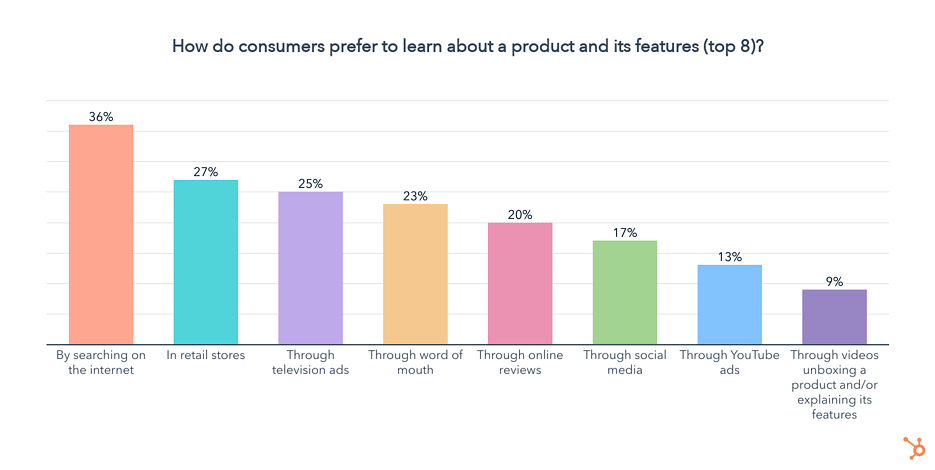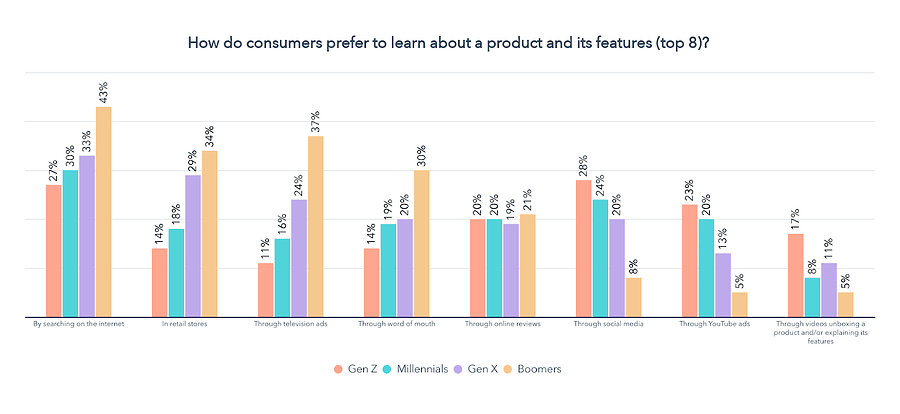You see an ad for a product that grabs your attention. What’s your next step? Do you Google the company, go to Amazon to see what the best deals or alternatives are, or do you check out their Instagram to see their user-generated videos?
As with all things marketing, what you do is not necessarily what your customers do. So where do your customers end up researching your products after they see an ad? That’s exactly the question that Hubspot tried to answer in their recent 2022 State of Consumer Trends Survey.
As you might imagine, their results vary widely across the generations of shoppers. This is yet another reason why it’s so important for brands to nail their target audience. If you know your customers then you know which channels are the most effective for you to optimize.
Join the Optily newsletter!
Stay up-to-date on platform changes, digital marketing tactics, and industry news. We promise we won’t spam!
Where are people going to learn more about products?
The short answer: online search. The graph below shows the results of Hubspot’s 1000-person survey asking this question.

Source: Hubspot
That being said, this is the overall spread. While it is interesting to see that retail stores and TV still rank towards the top, you may not be surprised to see the split looks very different when we factor in the different generations. The graph below shows the answers to the same question split across Gen Z, Millennials, Gen X, and Boomers.

Source: Hubspot
As you can see from the data in the graph above, the story gets a bit more interesting across the generations. The older generations, Boomers and Gen X, tend to favor internet searches, in-store browsing, TV ads, and word of mouth. While the younger generations, Gen Z and Millennials, tend to rely on social media, online reviews, and YouTube, in addition to searching.
So, what does this mean for your business?
Keep SEO as a priority
While other channels are definitely growing in popularity, the trusted Google search is not going anywhere fast. Regardless of your primary demographic, SEO should still be your main priority when it comes to product discovery from an organic standpoint.
SEO has definitely gotten harder in recent years, simply because more sites are out there. More sites mean more content. And since age is a factor, newer brands have to fight even harder to rank up.
Another big thing to keep in mind is mobile optimization. This is a factor in SEO but also a big UX turn-off if it’s not done properly. Make sure your mobile experience is as good (if not better) than on your desktop. More and more people each year are searching and shopping from their phones. Missing out on this market in 2022 is a huge loss!
We’ve talked a lot about SEO for Shopify stores, tech solutions that can help you optimize easier, and how to make product pages pop. So make sure you check out all of these resources when you’re looking into sprucing up your eCommerce site’s rankings.
Additionally, you want to keep in mind that people aren’t always shopping. Sometimes they’re just browsing around and stumble upon good content. Don’t always be hard selling in you website content for this reason. Listen to what Rishabh Jain has to say about the value of good content:
Expand to retail
If possible, you may consider having some of your products in physical stores. While we mostly focus on online shopping here, we do understand that many shoppers still discover products on the shelves.
Here’s a clip from our podcast where Greg Sterling explored the value of having a physical presence:
Especially if your demographic skew older, you may seriously want to consider taking a step outside of pure eCommerce.
The value of word of mouth
From the data above we can see that all generations value word of mouth in one form or another. While the older generations value actual word of mouth from friends or family, the younger generations rely on influencers and online reviews just as much. Whether it’s loyalty programs, encouraging reviews from loyal customers, or leveraging the power of influencers to grow your brand, word of mouth is a powerful tool.
Which version of word of mouth you choose to focus on will definitely depend on who you’re looking to target. Referral codes can help incentivize loyal customers to share to friends and family in order for both parties to get a discount. While encouraging users to post videos on Instagram with a hashtag can help you get authentic user-generated content for social media.
By knowing what each demographic is more comfortable with, you can change your tactics to encourage more spreading of the good word about your brand. After all, we all tend to trust a brand more when hearing from our friends or other real users online than just from ads.
Conclusion
With so many channels available from traditional to the latest social media platform, brands need to know where to focus their energy. It’s easy to say “be omnichannel,” but the reality of small marketing teams and budgets means businesses have to prioritize. By knowing your customers you can hone in on the channels and methods that they respond to the best.






